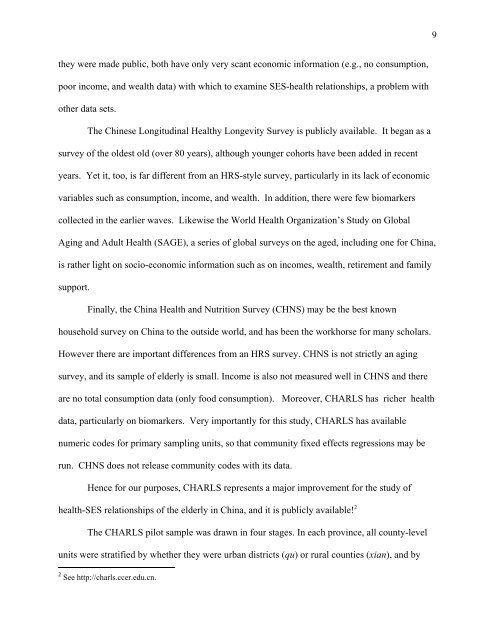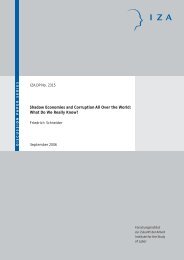Health Outcomes and Socio-Economic Status among ... - Index of - IZA
Health Outcomes and Socio-Economic Status among ... - Index of - IZA
Health Outcomes and Socio-Economic Status among ... - Index of - IZA
You also want an ePaper? Increase the reach of your titles
YUMPU automatically turns print PDFs into web optimized ePapers that Google loves.
they were made public, both have only very scant economic information (e.g., no consumption,<br />
poor income, <strong>and</strong> wealth data) with which to examine SES-health relationships, a problem with<br />
other data sets.<br />
The Chinese Longitudinal <strong>Health</strong>y Longevity Survey is publicly available. It began as a<br />
survey <strong>of</strong> the oldest old (over 80 years), although younger cohorts have been added in recent<br />
years. Yet it, too, is far different from an HRS-style survey, particularly in its lack <strong>of</strong> economic<br />
variables such as consumption, income, <strong>and</strong> wealth. In addition, there were few biomarkers<br />
collected in the earlier waves. Likewise the World <strong>Health</strong> Organization’s Study on Global<br />
Aging <strong>and</strong> Adult <strong>Health</strong> (SAGE), a series <strong>of</strong> global surveys on the aged, including one for China,<br />
is rather light on socio-economic information such as on incomes, wealth, retirement <strong>and</strong> family<br />
support.<br />
Finally, the China <strong>Health</strong> <strong>and</strong> Nutrition Survey (CHNS) may be the best known<br />
household survey on China to the outside world, <strong>and</strong> has been the workhorse for many scholars.<br />
However there are important differences from an HRS survey. CHNS is not strictly an aging<br />
survey, <strong>and</strong> its sample <strong>of</strong> elderly is small. Income is also not measured well in CHNS <strong>and</strong> there<br />
are no total consumption data (only food consumption). Moreover, CHARLS has richer health<br />
data, particularly on biomarkers. Very importantly for this study, CHARLS has available<br />
numeric codes for primary sampling units, so that community fixed effects regressions may be<br />
run. CHNS does not release community codes with its data.<br />
Hence for our purposes, CHARLS represents a major improvement for the study <strong>of</strong><br />
health-SES relationships <strong>of</strong> the elderly in China, <strong>and</strong> it is publicly available! 2<br />
The CHARLS pilot sample was drawn in four stages. In each province, all county-level<br />
units were stratified by whether they were urban districts (qu) or rural counties (xian), <strong>and</strong> by<br />
2 See http://charls.ccer.edu.cn.<br />
9
















